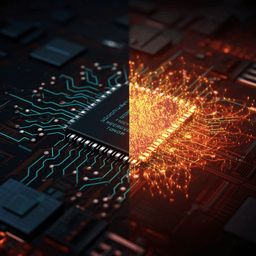
Engineering and Technology
Electron-beam-irradiated rhenium disulfide memristors with low variability for neuromorphic computing
S. Li, B. Li, et al.
Discover the groundbreaking potential of a two-terminal lateral memristor using electron-beam-irradiated rhenium disulfide (ReS2), showcasing stable and gradual resistive switching. This innovative research by Sifan Li, Bochang Li, Xuewei Feng, Li Chen, Yesheng Li, Li Huang, Xuanyao Fong, and Kah-Wee Ang paves the way for energy-efficient neuromorphic computing through Schottky barrier height modulation.
~3 min • Beginner • English
Introduction
Memristors are promising artificial synapses for neuromorphic computing, with most devices operating via conductive filament formation within insulating layers through valence change (anion vacancy migration) or electrochemical metallization (active metal cation motion). These filamentary mechanisms inherently suffer from stochastic filament formation/rupture, leading to significant cycle-to-cycle (temporal) variability in set/reset voltages. Although approaches such as epitaxial SiGe-based epiRAM confine filament growth and reduce variability, they still face temporal variation and integration challenges due to high-temperature processing incompatible with CMOS back-end-of-line integration. Two-dimensional (2D) materials offer low-temperature processing and transfer compatibility and have been used in vertical memristors leveraging native defects or oxide derivatives for low switching voltages. However, vertical two-terminal structures are less suitable for multi-terminal synaptic emulation. Lateral 2D memristors, particularly MoS2-based devices, have shown non-filamentary switching via voltage-driven sulfur vacancy motion that modulates metal/2D material SBH, potentially reducing variability. Rhenium disulfide (ReS2), with weak interlayer coupling, soft Re–S bonds, and low sulfur vacancy formation energy, is a strong candidate for pronounced vacancy motion under bias. Here, starting from single-crystalline 2D ReS2, the authors introduce sulfur vacancies via electron beam irradiation (EBI) to realize a forming-free lateral memristor exhibiting gradual RS, with small transition voltage variations (6.3% positive, 5.3% negative) attributed to SBH modulation by sulfur vacancy movement, and demonstrate rich synaptic functionalities.
Literature Review
Prior work on memristors identifies filamentary mechanisms: valence change (anion vacancies like oxygen) and electrochemical metallization (mobile cations such as Ag+, Cu+, Ti), both leading to stochastic filament dynamics and variability. Epitaxial SiGe epiRAM reduced set-voltage variation through dislocation engineering and filament confinement but retained temporal variation during filament erasure and required high-temperature MBE growth. 2D materials have enabled vertical memristors using intrinsic defects (e.g., S or B vacancies in MoS2, hBN, WSe2) and active metal filaments, showing both short- and long-term synaptic plasticity. 2D-derivative vertical devices (e.g., MoOx/MoS2, WOx/WSe2) achieve low switching voltages and high-density scaling but remain two-terminal. Lateral 2D memristors (e.g., MoS2) showed switching via voltage-driven S-vacancy motion and SBH modulation at contacts, offering non-filamentary gradual RS and potentially improved uniformity. ReS2 is advantageous due to its anisotropy, weak interlayer coupling, softer Re–S bonds, and particularly low S-vacancy formation energy, suggesting easier vacancy creation and motion. Defect engineering in ReS2 via electron beam, oxygen plasma, and helium ions typically yields S vacancies, supporting the approach of using EBI to tailor defects for memristive switching with lower variability.
Methodology
Device fabrication: Few-layer ReS2 flakes were mechanically exfoliated onto highly doped p-type Si substrates with 90 nm SiO2. Crystal orientation ([010]) was aligned via Raman spectroscopy. Electron beam irradiation (EBI) was applied using electron beam lithography to selectively irradiate the flake regions (contacts and/or active channel) with dosages of 0–8000 µC cm^-2. Ti/Au (10 nm/90 nm) electrodes were then patterned by EBL and deposited by e-beam evaporation, followed by standard lift-off in acetone. Devices were passivated with a PMMA layer. Electrode spacing was ~1.5 µm. Flake thicknesses around 3 nm (five layers) were typical; a range of thicknesses was also explored for thickness dependence.
Electrical characterization: DC I–V sweeps were performed at room temperature in ambient using a probe station and Agilent 4155B. The Si substrate was grounded; the right electrode was grounded for measurements while voltage was applied to the left electrode. Rectification-mediated switching was studied via positive (0→+V→0) and negative (0→−V→0) sweeps across varying ranges (e.g., ±5–±10 V). Transition voltages for backward-to-forward (B–F) and forward-to-backward (F–B) states were extracted based on I–V nonlinearity threshold (>5). Endurance was assessed over 100 DC cycles, with resistance states extracted at a fixed read bias of +0.5 V. Retention was evaluated without external bias. Temperature-dependent I–V was used to extract SBH at the right contact in FD and BD states.
Pulse measurements: Neuromorphic behaviors were emulated using a Keithley 4200-SCS with programmed pulse trains. Potentiation/depression used positive/negative pulse trains (typical width 10 ms, period 50 ms) with varying amplitudes (e.g., 2–5 V). Post-synaptic current (PSC) was read at a base voltage of +0.5 V; additional reads at ±5 V verified rectification changes. Spike-amplitude-dependent plasticity (SADP) was probed by varying pulse amplitudes and extracting synaptic weight change (current change at base voltage) between the first and tenth pulses. Paired-pulse facilitation/depression (PPF/PPD) experiments varied inter-pulse intervals; synaptic weight changes were extracted between first and second pulses. Spike-timing-dependent plasticity (STDP) was emulated via an equivalent single-pulse waveform applied to the pre-synaptic terminal with controlled time delays; weight changes were fitted with exponentials to extract time constants.
Materials characterization: Transmission electron microscopy (TEM) and scanning TEM (STEM) cross-sections examined EBI-induced lattice disorder at contacts, contact edges, and channel. AFM phase imaging assessed topography post-EBI. Raman (125–225 cm^-1 and full range) and photoluminescence (PL, excitation 532 nm, <100 µW) evaluated defect-induced shifts and quenching; spectra were recorded at fixed orientation to avoid anisotropy effects. X-ray photoelectron spectroscopy (XPS, Al Kα) measured Re 4f and S 2p core levels, binding energy shifts, and S/Re atomic ratios before and after EBI. Energy-dispersive X-ray spectroscopy (EDX) line scans probed metal/ReS2 contact nature. Selective EBI controls (contacts only, contacts+channel, channel only) identified the origin of switching. All material data supported the formation of sulfur vacancies as the dominant defects and their role in SBH modulation.
Key Findings
- A lateral two-terminal ReS2 memristor with EBI-engineered defects exhibits forming-free, gradual resistive switching with rectification-mediated characteristics requiring fixed read polarity.
- Mechanism: Voltage-bias-induced motion of negatively charged sulfur vacancies modulates the metal/ReS2 Schottky barrier heights at contacts, toggling between forward-diode (FD) and backward-diode (BD) states. Selective EBI controls and temperature-dependent extractions confirm SBH reduction at the right contact when switching from BD to FD.
- Variability: Minimal cycle-to-cycle transition voltage variations of 6.3% (B–F under positive sweeps) and 5.3% (F–B under negative sweeps) over 100 DC cycles, substantially lower than typical filamentary MIM memristors.
- RS ratio and sweep dependence: At a fixed read of +0.5 V, FD/BD current ratio increases with voltage sweep range, from ~20× to ~70× as the sweep extends to ±10 V.
- Endurance: Over 100 cycles, FD and BD resistances (read at +0.5 V) show an RS ratio ~50×; absolute resistances drift upward due to device degradation (vacancy motion-induced damage).
- Retention: FD and BD states retained for >700 s without bias; shorter than typical non-volatile memory but longer than volatile devices, consistent with mobile S vacancies (low diffusion barrier in ReS2).
- EBI dosage optimization: For ~3 nm flakes, 6000 µC cm^-2 yields the largest average RS ratio; too low dosage yields insufficient vacancies, while too high dosage increases series resistance, reducing RS ratio.
- Thickness dependence: A critical thickness around 5 nm was identified for a marked increase in RS ratio; beyond certain thicknesses, RS behavior vanishes due to reduced vacancy density at a given dosage.
- Electric field: Device operation fields (~3×10^4 V cm^-1 across 1.5 µm) are comparable to minimum activation fields reported for vacancy motion in related 2D systems; softer Re–S bonds may enable vacancy motion at lower fields.
- Synaptic functions: Demonstrated long-term potentiation (LTP) and depression (LTD), SADP (larger pulse amplitudes induce greater weight change), PPF/PPD (higher spike frequency/lower intervals increase weight change), and STDP with fitted time constants of ~16 ms (Δt>0) and ~60 ms (Δt<0).
Discussion
The work addresses the variability challenge inherent to filamentary memristors by employing a non-filamentary switching mechanism based on SBH modulation driven by sulfur vacancy motion in ReS2. By creating and mobilizing vacancies via EBI and applied bias, the devices realize gradual, controllable changes in contact barriers rather than stochastic filament formation/rupture, leading to markedly reduced cycle-to-cycle transition voltage variability. The rectification-mediated switching, while necessitating a fixed read polarity, provides stable and analog-like conductance modulation beneficial for neuromorphic learning rules. Material analyses (TEM, AFM, Raman, PL, XPS) substantiate sulfur vacancy creation with EBI and correlate with electrical behavior; temperature-dependent measurements directly confirm SBH modulation correlating with FD/BD states. The observed retention and endurance trends align with a mobile-defect mechanism and indicate a trade-off between strong modulation and device degradation over time. Optimization of EBI dosage and flake thickness tunes RS ratio and robustness. Demonstrated synaptic functions (LTP/LTD, SADP, PPF/PPD, STDP) show the device’s suitability for neuromorphic systems, with near-biological time constants, and the low variability supports improved learning accuracy. Overall, the findings validate lateral ReS2 memristors with engineered defect landscapes as promising artificial synapses with superior temporal uniformity.
Conclusion
Electron-beam-irradiated lateral ReS2 memristors achieve forming-free, gradual resistive switching via voltage-driven sulfur vacancy motion that modulates contact SBH, delivering minimal transition voltage variability (6.3%/5.3%), sizable and tunable RS ratios, and robust emulation of key synaptic behaviors (LTP/LTD, SADP, PPF/PPD, STDP). Comprehensive material characterizations confirm sulfur vacancies as the dominant, mobile defects induced by EBI. The rectification-mediated switching scheme reduces temporal variability relative to filamentary devices, highlighting potential for energy-efficient neuromorphic computing. Future work should focus on improving retention and endurance, optimizing contact engineering, refining defect generation (e.g., controlled ion/e-beam dosing), scaling with uniform CVD-grown ReS2 to evaluate spatial variability, lowering operating voltages and fields, and exploring multi-terminal architectures for richer synaptic functionalities.
Limitations
- Retention time (>700 s) is limited compared to typical non-volatile memristors (~1500 minutes reported elsewhere), indicating high vacancy mobility and potential data volatility over longer timescales.
- Endurance shows resistance drift due to device degradation from repeated vacancy movement, suggesting reliability trade-offs.
- Spatial (device-to-device) variability could not be rigorously assessed due to reliance on mechanically exfoliated flakes with uncontrolled thickness/geometry; large-area CVD films are needed for systematic studies.
- The rectification-mediated switching necessitates a fixed read polarity (e.g., +0.5 V), which may constrain readout schemes.
- Excessive EBI dosage increases series resistance, reducing RS ratio; too low dosage yields insufficient defects, indicating a narrow process window.
- RS behavior diminishes in thicker flakes at the same dosage due to lower vacancy density, imposing thickness constraints.
- Electric fields used are relatively high for lateral geometries; reducing operating voltages would be beneficial for practical integration.
Related Publications
Explore these studies to deepen your understanding of the subject.







